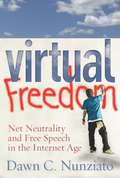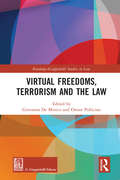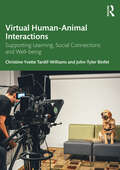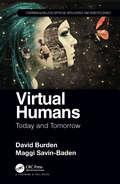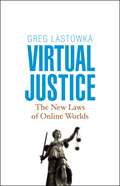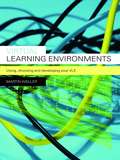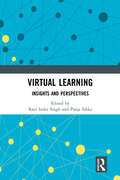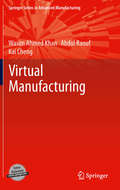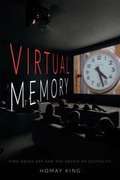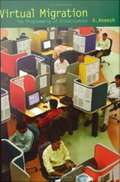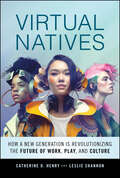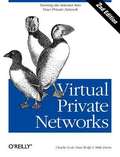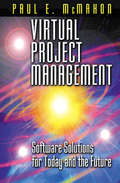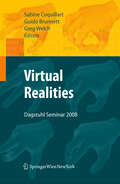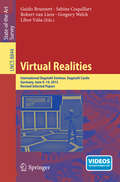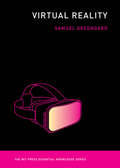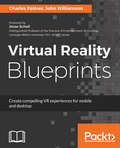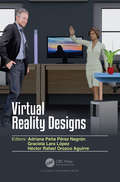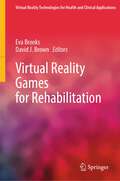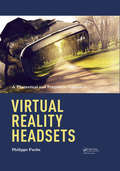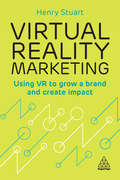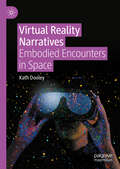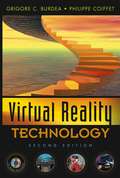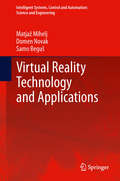- Table View
- List View
Virtual Freedom
by Dawn C. NunziatoCommunications giants like Google, Comcast, and AT&T enjoy increasingly unchecked control over speech. As providers of broadband access and Internet search engines, they can control online expression. Their online content restrictions-from obstructing e-mail to censoring cablecasts-are considered legal because of recent changes in free speech law. In this book, Dawn Nunziato criticizes recent changes in free speech law in which only the government need refrain from censoring speech, while companies are permitted to self-regulate. By enabling Internet providers to exercise control over content, the Supreme Court and the FCC have failed to protect the public's right to access a broad diversity of content. Nunziato argues that regulation is necessary to ensure the free flow of information and to render the First Amendment meaningful in the twenty-first century. This book offers an urgent call to action, recommending immediate steps to preserve our free speech rights online.
Virtual Freedoms, Terrorism and the Law (Routledge-Giappichelli Studies in Law)
by Giovanna De MinicoThis book examines the risks to freedom of expression, particularly in relation to the internet, as a result of regulation introduced in response to terrorist threats. The work explores the challenges of maintaining security in the fight against traditional terrorism while protecting fundamental freedoms, particularly online freedom of expression. The topics discussed include the clash between freedom of speech and national security; the multijurisdictional nature of the internet and the implications for national sovereignty and transnational legal structures; how to determine legitimate and illegitimate association online; and the implications for privacy and data protection. The book presents a theoretical analysis combined with empirical research to demonstrate the difficulty of combatting internet use by terror organizations or individuals and the range of remedies that might be drawn from national and international law. The work will be essential reading for students, researchers and policy makers in the areas of Constitutional law; Criminal Law, European and International law, Information and Technology law and Security Studies.
Virtual Human-Animal Interactions: Supporting Learning, Social Connections and Well-being
by John-Tyler Binfet Christine Yvette Tardif-WilliamsInterest in the field of human-animal interactions is burgeoning, and researchers and educators are keen to understand the science undergirding research that helps us understand interactions between people and animals. Recently, exciting and innovative research is focusing on how people’s virtual interactions with animals can enhance their learning, social interactions, and well-being. This research aims to answer questions such as, "What types of interactions do people have with animals in a virtual context? How do people access and experience their virtual interactions with animals? Do virtual interactions with animals hold potential to enhance people’s well-being and learning in the same way that in-person interactions with animals have been documented? What educational strategies could be employed to enhance people’s virtual interactions with animals? How can we respect animals as research participants within a virtual context?" Drawing from seminal and cutting-edge research in the field of human-animal interactions, these questions and others are answered in Virtual Human-Animal Interactions. Research-informed and grounded in critical discussions of theory and practice, this book challenges readers to reconceptualize their understanding of research and practice exploring the complexities inherent in, and arising from, people’s virtual interactions with animals. Further, with an eye to the future, this book illuminates readers’ thinking around the empirical and practical implications of facilitating interactions between people and animals within virtual contexts. Researchers and educators from across disciplines will find Virtual Human-Animal Interactions both scientifically savvy and practical.
Virtual Humans: Today and Tomorrow (Chapman & Hall/CRC Artificial Intelligence and Robotics Series)
by Maggi Savin-Baden David BurdenVirtual Humans provides a much-needed definition of what constitutes a ‘virtual human’ and places virtual humans within the wider context of Artificial Intelligence development. It explores the technical approaches to creating a virtual human, as well as emergent issues such as embodiment, identity, agency and digital immortality, and the resulting ethical challenges. The book presents an overview of current research and practice in this area, and outlines the major challenges faced by today’s developers and researchers. The book examines the possibility for using virtual humans in a variety of roles, from personal assistants to teaching, coaching and knowledge management, and the book situates these discussions around familiar applications (e.g. Siri, Cortana, Alexa) and the portrayal of virtual humans within Science Fiction. Features Presents a comprehensive overview of this rapidly developing field Provides an array of relevant, real-life examples from expert practitioners and researchers from around the globe in how to create the avatar body, mind, senses and ability to communicate Intends to be broad in scope yet practical in approach, so that it can serve the needs of several different audiences, including researchers, teachers, developers and anyone with an interest in where these technologies might take us Covers a wide variety of issues which have been neglected in other research texts; for example, definitions and taxonomies, the ethical challenges of virtual humans and issues around digital immortality Includes numerous examples and extensive references
Virtual Justice
by Greg LastowkaTens of millions of people today are living part of their life in a virtual world. In places like World of Warcraft, Second Life, and Free Realms, people are making friends, building communities, creating art, and making real money. Business is booming on the virtual frontier, as billions of dollars are paid in exchange for pixels on screens. But sometimes things go wrong. Virtual criminals defraud online communities in pursuit of real-world profits. People feel cheated when their avatars lose virtual property to wrongdoers. Increasingly, they turn to legal systems for solutions. But when your avatar has been robbed, what law is there to assist you? InVirtual Justice,Greg Lastowka illustrates the real legal dilemmas posed by virtual worlds. Presenting the most recent lawsuits and controversies, he explains how governments are responding to the chaos on the cyberspace frontier. After an engaging overview of the history and business models of today's virtual worlds, he explores how laws of property, jurisdiction, crime, and copyright are being adapted to pave the path of virtual law. Virtual worlds are becoming more important to society with each passing year. This pioneering study will be an invaluable guide to scholars of online communities for years to come.
Virtual Learning Environments: Using, Choosing and Developing your VLE
by Martin WellerVirtual learning environments are widely spread in higher education, yet they are often under utilised by the institutions that employ them. This book addresses the need to move beyond thinking about the VLE simply in terms of the particular package that an institution has adopted, and viewing it as a significant educational technology that will shape much of the teaching and learning process in the coming years. Considering how virtual learning environments can be successfully deployed and used for effective teaching, it sets out a model for effective use, focussing on pedagogic application rather than a specific technology, and seeks to provide a bridge between pedagogical approaches and the tools educators have at their disposal. It contains essential advice for those choosing a VLE and encourages all those involved in the deployment of a VLEs to use them more productively in order to create engaging learning experiences.
Virtual Learning: Insights and Perspectives
by Ravi Inder Singh Pooja SikkaThis book brings together the research work conducted by renowned academics and practitioners on critical and immensely important issues of virtual learning. It provides innovative ideas and empirical findings on the subject. The sixteen chapters by established and young scholars from all over the country offer strong theoretical and analytical discussion, and examine a wide range of issues confronting the education sector in India in general and the higher education sector in particular. The book seeks to address pertinent issues relating to virtual learning like emerging scenario with respect to required changes in pedagogy used in higher education learning, perceptions of learners about online mode of learning, problems and challenges in virtual learning, paradigm shifts in higher education, designing of new learning strategies for online mode of learning and about the role virtual learning plays in inclusive growth. The scholarly discussion of the book will serve as an excellent vade mecum for readers who want to understand the various dimensions of virtual learning, specifically those that emerged during the Covid-19 Pandemic period, and will provide opportunities to researchers to use it as reference to pursue research in the field of virtual learning.
Virtual Manufacturing
by Kai Cheng Abdul Raouf Wasim Ahmed KhanVirtual Manufacturing presents a novel concept of combining human computer interfaces with virtual reality for discrete and continuous manufacturing systems. The authors address the relevant concepts of manufacturing engineering, virtual reality, and computer science and engineering, before embarking on a description of the methodology for building augmented reality for manufacturing processes and manufacturing systems. Virtual Manufacturing is centered on the description of the development of augmented reality models for a range of processes based on CNC, PLC, SCADA, mechatronics and on embedded systems. Further discussions address the use of augmented reality for developing augmented reality models to control contemporary manufacturing systems and to acquire micro- and macro-level decision parameters for managers to boost profitability of their manufacturing systems. Guiding readers through the building of their own virtual factory software, Virtual Manufacturing comes with access to online files and software that will enable readers to create a virtual factory, operate it and experiment with it. This is a valuable source of information with a useful toolkit for anyone interested in virtual manufacturing, including advanced undergraduate students, postgraduate students and researchers.
Virtual Memory: Time-Based Art and the Dream of Digitality
by Homay KingIn Virtual Memory, Homay King traces the concept of the virtual through the philosophical works of Henri Bergson, Gilles Deleuze, and Giorgio Agamben to offer a new framework for thinking about film, video, and time-based contemporary art. Detaching the virtual from its contemporary associations with digitality, technology, simulation, and speed, King shows that using its original meaning--which denotes a potential on the cusp of becoming--provides the means to reveal the "analog" elements in contemporary digital art. Through a queer reading of the life and work of mathematician Alan Turing, and analyses of artists who use digital technologies such as Christian Marclay, Agnès Varda, and Victor Burgin, King destabilizes the analog/digital binary. By treating the virtual as the expression of powers of potential and change and of historical contingency, King explains how these artists transcend distinctions between disembodiment and materiality, abstraction and tangibility, and the unworldly and the earth-bound. In so doing, she shows how their art speaks to durational and limit-bound experience more than contemporary understandings of the virtual and digital would suggest.
Virtual Migration: The Programming of Globalization
by A. AneeshAneesh draws on the sociology of science, social theory, and research on migration to illuminate the practical and theoretical ramifications of virtual migration.
Virtual Natives: How a New Generation is Revolutionizing the Future of Work, Play, and Culture
by Leslie Shannon Catherine D. HenryThe eclipse of Digital Natives and the dawn of virtual culture—how Gen A, Z are radically redefining the future of work, play, economics, and social life. We’re living through what is arguably one of the most exciting, confusing, and powerful social moments in the history of humanity, the shift from the Digital Age to the Virtual Age. This shift is being driven by technology, and the people who are leading it are the ones who know it best: the Virtual Natives. This book will introduce you to the Virtual Native cohort and mindset, decipher their socio-cultural and economic experiences, and unpack their expectations of companies looking to engage, market, or employ them. In this book, we explore: How Virtual Natives are deploying the new technologies driving the virtualized world How relationships and work habits are being virtualized Identify ten main Virtual Native-led behaviors that are upending work and culture How Virtual Natives are evolving their expertise into a full-blown economy This is nothing short of a cultural revolution. Virtual Natives are the driving force behind a seismic change that is redefining the world through technology and virtual worlds: this book tells you how they are navigating everything from AI to Augmented and virtual reality, gaming, blockchain and Web3 in easy, accessible language. To understand the future, read Virtual Natives.
Virtual Private Networks, Second Edition
by Mike Erwin Charlie Scott Paul WolfeThis book explains how to plan and build a Virtual Private Network (VPN), a collection of technologies that creates secure connections or "tunnels" over regular Internet lines. It discusses costs, configuration, and how to install and use VPN technologies that are available for Windows NT and Unix, such as PPTP and L2TP, Altavista Tunnel, Cisco PIX, and the secure shell (SSH). New features in the second edition include SSH and an expanded description of the IPSec standard.
Virtual Project Management: Software Solutions for Today and the Future
by Paul E. McMahonVirtual Project Management: Software Solutions for Today and the Future explores the technical management issues involved in the revolutionary new way of building complex software intensive systems faster and cheaper by employing the power of distributed operations. The book examines the implementation issues that cut deep inside present day colloc
Virtual Realities
by Greg Welch Guido Brunnett Sabine CoquillartThe articles by well-known international experts intend to facilitate more elaborate expositions of the research presented at the seminar, and to collect and document the results of the various discussions, including ideas and open problems that were identified. Correspondingly the book will consist of two parts. Part I will consist of extended articles describing research presented at the seminar. This will include papers on tracking, motion capture, displays, cloth simulation, and applications. Part II will consist of articles that capture the results of breakout discussions, describe visions, or advocate particular positions. This will include discussions about system latency, 3D interaction, haptic interfaces, social gaming, perceptual issues, and the fictional "Holodeck".
Virtual Realities
by Robert Van Liere Guido Brunnett Sabine Coquillart Gregory Welch Libor VášaVirtual reality (VR) is a multidisciplinary area of research aimed at interactive human-computer-mediated simulations of artificial environments. An important aspect of VR-based systems is the stimulation of the human senses - usually sight, sound, and touch - in such a way that a user feels a sense of presence in the virtual environment. Sometimes it is important to combine real and virtual objects in the same real or virtual environment. This approach is often referred to as augmented reality (AR), when virtual objects are integrated into a real environment. Typical VR applications include simulation, training, scientific visualization, and entertainment, whereas typical AR applications include computer-aided manufacturing or maintenance and computer-aided surgery or medicine. This book comprises a collection of research and position papers presented at Dagstuhl Seminar 13241 on Virtual Realities, held at Schloss Dagstuhl, Germany, in June 2013. The 13 papers in this volume were carefully reviewed and selected from 18 submissions. They are organized in topical sections on: VR environments; interactions and user experience; virtual humans; and tele-existence.
Virtual Reality (The MIT Press Essential Knowledge series)
by Samuel GreengardA comprehensive overview of developments in augmented reality, virtual reality, and mixed reality—and how they could affect every part of our lives.After years of hype, extended reality—augmented reality (AR), virtual reality (VR), and mixed reality (MR)—has entered the mainstream. Commercially available, relatively inexpensive VR headsets transport wearers to other realities—fantasy worlds, faraway countries, sporting events—in ways that even the most ultra-high-definition screen cannot. AR glasses receive data in visual and auditory forms that are more useful than any laptop or smartphone can deliver. Immersive MR environments blend physical and virtual reality to create a new reality. In this volume in the MIT Press Essential Knowledge series, technology writer Samuel Greengard offers an accessible overview of developments in extended reality, explaining the technology, considering the social and psychological ramifications, and discussing possible future directions.Greengard describes the history and technological development of augmented and virtual realities, including the latest research in the field, and surveys the various shapes and forms of VR, AR, and MR, including head-mounted displays, mobile systems, and goggles. He examines the way these technologies are shaping and reshaping some professions and industries, and explores how extended reality affects psychology, morality, law, and social constructs. It's not a question of whether extended reality will become a standard part of our world, he argues, but how, when, and where these technologies will take hold. Will extended reality help create a better world? Will it benefit society as a whole? Or will it merely provide financial windfalls for a select few? Greengard's account equips us to ask the right questions about a transformative technology.
Virtual Reality Blueprints: Create compelling VR experiences for mobile and desktop
by John Williamson Charles PalmerJoin the virtual reality revolution by creating immersive 3D games and applications with Cardboard VR, Gear VR, OculusVR, and HTC Vive Key Features Develop robust, immersive VR experiences that are easy on the eye. Code 3D games and applications using Unity 3D game engine. Learn the basic principles of virtual reality applications Book Description Are you new to virtual reality? Do you want to create exciting interactive VR applications? There's no need to be daunted by the thought of creating interactive VR applications, it's much easier than you think with this hands-on, project-based guide that will take you through VR development essentials for desktop and mobile-based games and applications. Explore the three top platforms—Cardboard VR, Gear VR, and OculusVR —to design immersive experiences from scratch. You’ll start by understanding the science-fiction roots of virtual reality and then build your first VR experience using Cardboard VR. You'll then delve into user interactions in virtual space for the Google Cardboard then move on to creating a virtual gallery with Gear VR. Then you will learn all about virtual movements, state machines, and spawning while you shoot zombies in the Oculus Rift headset. Next, you'll construct a Carnival Midway, complete with two common games to entertain players. Along the way, you will explore the best practices for VR development, review game design tips, discuss methods for combating motion sickness and identify alternate uses for VR applications What you will learn Use Unity assets to create object simulation. Implement simple touch controls in your application. Apply artificial intelligence to achieve player and character interaction. Add scripts for movement, tracking, grasping, and spawning. Create animated walkthroughs, use 360-degree media, and build engaging VR experiences. Deploy your games on multiple VR platforms. Who this book is for If you are a game developer and a VR enthusiast now looking to get stuck into the VR app development process by creating VR apps for different platforms, then this is the book for you. Familiarity with the Unity game engine and the C# language is key to getting the most from this book.
Virtual Reality Designs
by Adriana Peña Pérez Negrón Graciela Lara López Héctor Rafael Orozco AguirreVirtual Reality is not real life. Instead it is life-like creations using computer-generated scenarios. Human behavior is replicated in virtual scenarios, where every detail is controlled by computers, and in situations that can be repeated under the same conditions. Based on technology and design, the user can experience presence. In the virtual world, users are embodied in avatars that represent them and are the means to interact with the virtual environment. Avatars are graphical models that behave on behalf of the human behind them. The user avatar is a proxy that also backs interaction with others, allowing computer-mediated interactions. Analyses directed to understand people’s perceptions, personal and social behavior in computer mediated interactions, comprise a multidisciplinary area of study that involves, among others, computer science, psychology and sociology. In the last two decades a number of studies supported by Virtual Reality have been conducted to understand human behavior, in some cases the implications of the technology, or to reproduce artificial human behavior. This book presents a collection of studies from recognized researchers in the area.
Virtual Reality Games for Rehabilitation (Virtual Reality Technologies for Health and Clinical Applications)
by Eva Brooks David J. BrownThis volume focuses on games to manage and facilitate rehabilitation. It emphasizes user practice, attitudes, and experience, and their changing place within developing rehabilitation frameworks. It looks at how users have adopted, integrated, and innovated with games to facilitate rehabilitation. Topics include game technology, game design and accessibility, web-based technologies vs pervasive and mobile technologies, social and collaborative aspects, and rehabilitative outcome. Games for rehabilitation are gaining interest from different communities such as medicine, psychology, and rehabilitation. A distinction can be made between games specifically made for rehabilitative purposes and games made for the general public but that are used in rehabilitation as well. Games have allowed the building of new/complementary forms for rehabilitation and offered new options to produce rehabilitative activities and experiences.
Virtual Reality Headsets - A Theoretical and Pragmatic Approach
by Philippe FuchsThe purpose of virtual reality is to make possible a sensorimotor and cognitive activity for a user in a digitally created artificial world. Recent advances in computer technology have led to a new generation of VR devices such as VR headsets. Accordingly, virtual reality poses many new scientific challenges for researchers and professionals. The aim of this book, a manual meant for both designers and users of virtual reality, is to present the current state of knowledge on the use of VR headsets in the most complete way possible. The book is divided into 13 chapters. The objective of the first chapter is to give an introduction to VR and clarify its scope. The next chapter presents a theoretical approach to virtual reality through our Immersion and Interaction methodology also known as "3I² model’’. Then, a chapter about human senses is necessary to understand the sensorimotor immersion, especially vision. These chapters are followed by several chapters which present the different visual interfaces and the VR headsets currently available on the market. These devices can impart comfort and health problems due to sensorimotor discrepancies. A chapter is devoted to these problems, followed by a chapter that gives a detailed discussion of methods and 32 solutions to dispel, or at least to decrease, VR sickness. The following three chapters present different VR applications that use VR headsets (behavioural sciences, industrial uses and Digital Art) and the final chapter provides conclusions and discusses future VR challenges.
Virtual Reality Marketing: Using VR to Grow a Brand and Create Impact
by Henry StuartIf a picture is worth a thousand words, then virtual reality (VR) is priceless. This new medium is booming - by 2025, the industry is expected to become bigger than TV. Virtual Reality Marketing is a comprehensive exploration of all things VR, providing readers with everything they need to know about the current VR landscape, and the unprecedented opportunity it offers brands to create unique emotional connections with consumers. A truly comprehensive guide, Virtual Reality Marketing covers all aspects of the industry, including interactive and passive VR, 360 video, social VR marketing, and the role that influencers and bloggers are set to play in its development. It also looks to the future - exploring how VR is evolving and the changes it will undergo in the future. Virtual Reality Marketing is the only complete guide to VR marketing available, written by a recognized industry expert who has facilitated VR coverage for major international brands including Facebook, Audi, Google and Mercedes F1. Packed with fascinating case studies, tips and strategies, this text is the leading resource for any reader looking to incorporate VR in their own marketing campaigns.
Virtual Reality Narratives: Embodied Encounters in Space
by Kath DooleyThis monograph delves into recent evolutions in virtual reality (VR) storytelling, focusing on entertainment-based works created or launched since 2020. Through various case studies, it showcases the increasing diversity and sophistication of recent narrative-based projects. Moving past the initial hype associated with the latest wave of VR, a number of innovative and affective works combining documentary-based or fictional storytelling with game mechanics, live theatre and other elements, have appeared at festivals or on distribution platforms in recent years. These interdisciplinary works have much to tell us about the future of VR storytelling but have yet to receive sustained analysis. This book aims to correct that. Dooley argues that VR, as an interactive medium that places the user inside a storyworld in a visible or invisible virtual body, offers narratives that incorporate the user’s body as a storytelling tool. This fosters user-centred stories that unfold in three-dimensional space. Adopting phenomenological and formal analysis methodologies, the monograph examines case studies through their approaches to narrative, style, and interactive devices. Key concepts that are explored include agency, direct address, environmental and spatial storytelling, embodiment and presence. By providing a much-needed analysis of works through a variety of theoretical lenses, the book illustrates how recent VR storytelling fosters powerfully transformative experiences.
Virtual Reality Technology
by Grigore C. Burdea Philippe CoiffetA groundbreaking Virtual Reality textbook is now even better Virtual reality is a very powerful and compelling computer application by which humans interact with computer-generated environments in a way that mimics real life and engages various senses. Although its most widely known application is in the entertainment industry, the real promise of virtual reality lies in such fields as medicine, engineering, oil exploration, and the military, to name just a few. Through virtual reality, scientists can triple the rate of oil discovery, pilots can dogfight numerically superior "bandits," and surgeons can improve their skills on virtual (rather than real) patients. This Second Edition of the first comprehensive technical book on virtual reality provides updated and expanded coverage of the technology such as: Input and output interfaces including touch and force feedback Computing architecture (with emphasis on the rendering pipeline and task distribution) Object modeling (including physical and behavioral aspects) Programming for virtual reality (WorldToolKit, Java 3D, GHOST, and PeopleShop) An in-depth look at human factors issues, user performance, and sensorial conflict aspects of VR Traditional and emerging VR applications The new edition of Virtual Reality Technology is specifically designed for use as a textbook. Thus, it includes definitions, review questions, and a CD-ROM with video clips that reinforce the topics covered. The CD-ROM also contains a Laboratory Manual with homework and programming assignments in VRML and Java 3D, as follows: Introduction to VRML and Java 3D Sensor and Event Processing VRML and JavaScript Scene Hierarchy, Geometry, and Texture VRML PROTO and Glove Devices Viewpoint Control, Sound, and Haptic Effects The Second Edition will serve as a state-of-the-art resource for both undergraduate and graduate students in engineering, computer science, and other disciplines.
Virtual Reality Technology (Ieee Press Ser.)
by Grigore C. Burdea Philippe CoiffetThorough overview of virtual reality technology fundamentals and latest advances, with coverage of hardware, software, human factors and applications, plus companion Laboratory Manual in Unity 3D. The Third Edition of the first comprehensive technical book on the subject of virtual reality, Virtual Reality Technology, provides updated and expanded coverage of VR technology, including where it originated, how it has evolved, and where it is going. Its primary objective is to be a complete, up-to-date textbook, as well as a source of information on a rapidly developing field of science and technology with broad societal impact. The two highly qualified authors cover all of the latest innovations and applications that are making virtual reality more important than ever before. Unlike other books on the subject, the book also includes a chapter on Human Factors, which are very important in designing technology around the human user. Virtual Reality Technology provides Instructors with a website-accessible Laboratory Manual using the Unity 3D game engine and programming language. Unity 3D is the preferred VR language these days and will prepare the student for the VR gaming and mobile applications industry. For universities Unity 3D is cost-effective as its student license is freely available. With comprehensive coverage of the subject, Virtual Reality Technology discusses sample topics such as: Input and output interfaces, including holographic displays, foveated head-mounted displays, neural interfaces, haptic and olfactory feedback Computing architecture, with emphasis on the rendering pipeline, the graphics processing unit and distributed/edge rendering Object modeling, including physical and behavioral aspects, Artificial Intelligence controlled characters, and model management techniques Programming toolkits for virtual reality and the game production pipeline Human factors issues such as user performance and sensorial conflict, cybersickness and societal impact aspects of VR Application examples in medical education, virtual rehabilitation, virtual heritage, gaming, and military use of virtual reality. Virtual Reality Technology provides thorough and complete coverage of an in-demand sector of technology, making it a highly valuable resource for undergraduate and graduate students in computer science, engineering, and science, along with a variety of professionals across many different industries, including but not limited to engineering, gaming, healthcare, and defense.
Virtual Reality Technology and Applications
by Matjaž Mihelj Domen Novak Samo BegusAs virtual reality expands from the imaginary worlds of science fiction and pervades every corner of everyday life, it is becoming increasingly important for students and professionals alike to understand the diverse aspects of this technology. This book aims to provide a comprehensive guide to the theoretical and practical elements of virtual reality, from the mathematical and technological foundations of virtual worlds to the human factors and the applications that enrich our lives: in the fields of medicine, entertainment, education and others. After providing a brief introduction to the topic, the book describes the kinematic and dynamic mathematical models of virtual worlds. It explores the many ways a computer can track and interpret human movement, then progresses through the modalities that make up a virtual world: visual, acoustic and haptic. It explores the interaction between the actual and virtual environments, as well as design principles of the latter. The book closes with an examination of different applications, focusing on augmented reality as a special case. Though the content is primarily VR-related, it is also relevant for many other fields.
